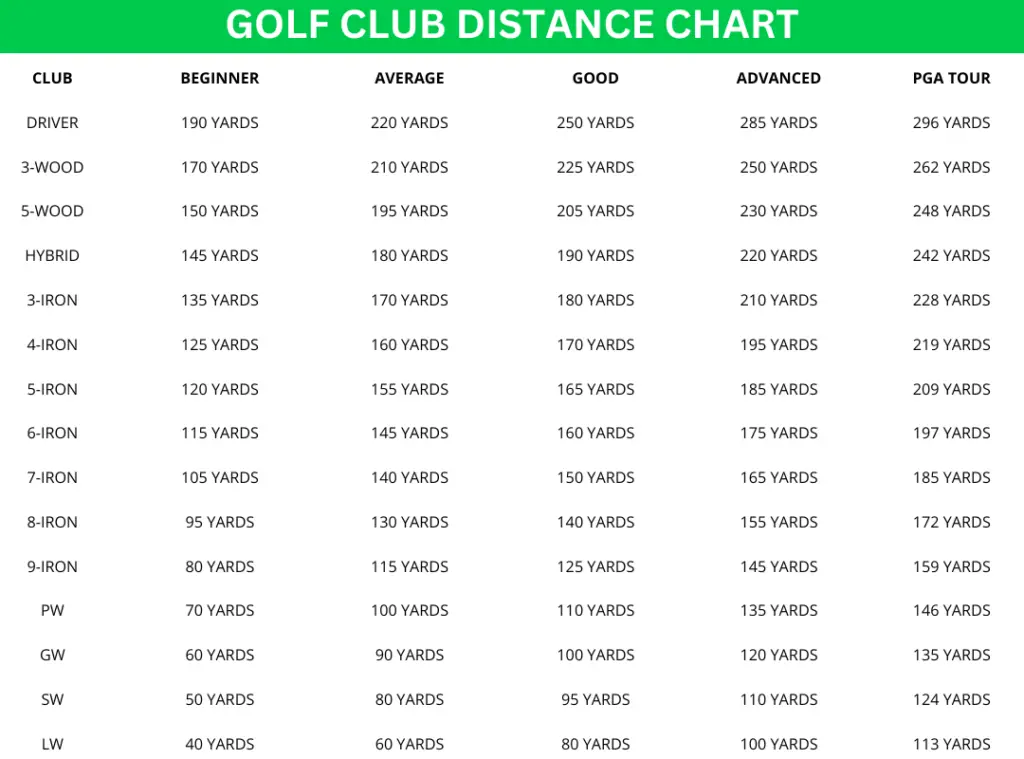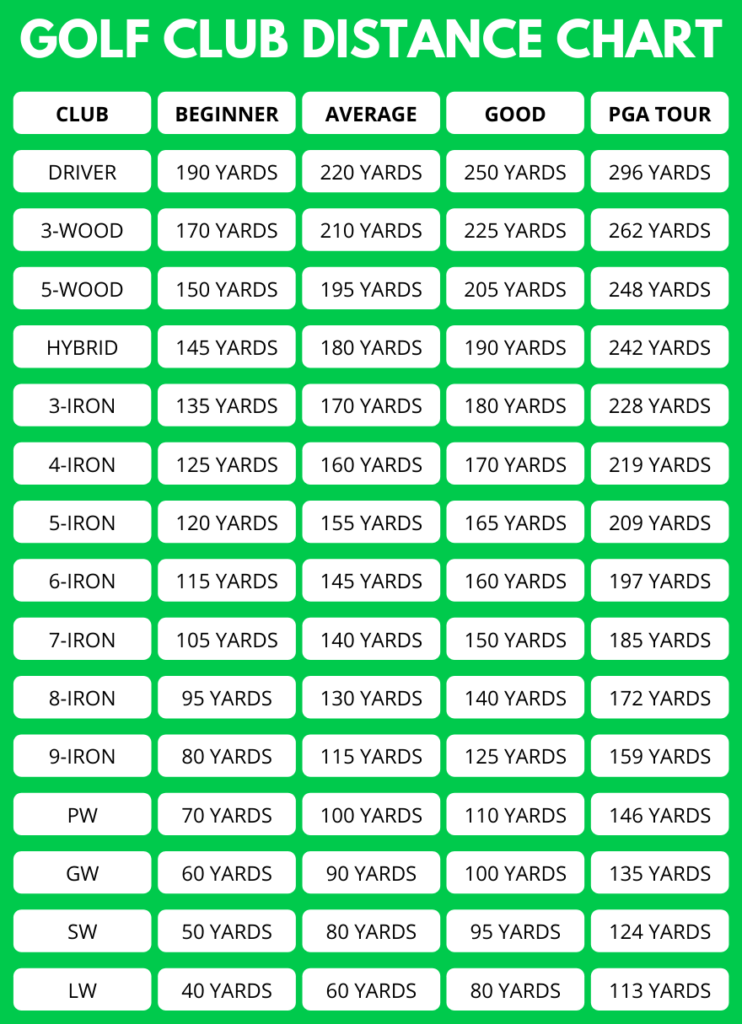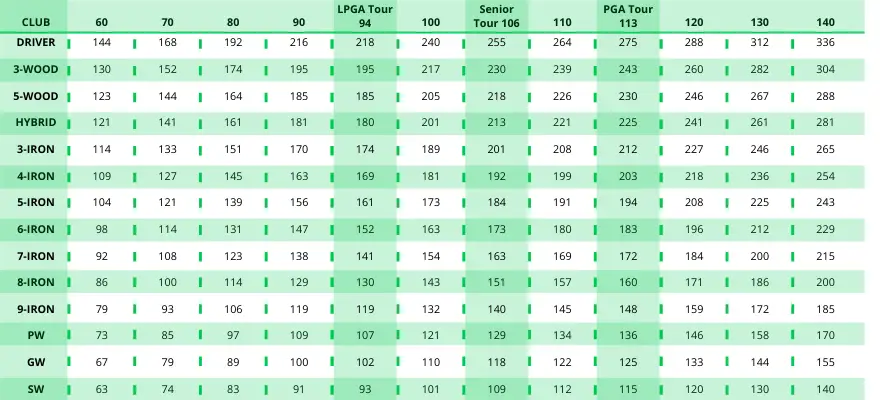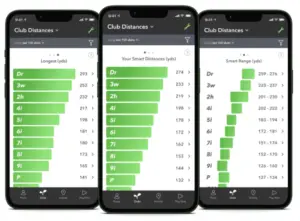Golf Club Distance Charts – Find Your Average Yardages (2025)
Golf club distance charts are essential tools for golfers of all skill levels, offering a clear guide to typical distances for each club.
They’re particularly helpful for beginner golfers, aiding in club selection and course strategy without the need for expensive equipment like GPS rangefinders or launch monitors.
While individual distances can vary based on factors like swing speed and physical ability, these charts provide a foundational understanding of yardages and can boost your confidence on the course.
In this guide, we’ll dive into the significance of understanding your yardages, reveal key factors for increasing distance, and offer guidance on creating personalized yardage charts.
Disclaimer: The following charts provide generalized yardages for each club segmented by skill level. It is for informational purposes only and should not be considered a substitute for personalized data. Individual swing speed, launch angle, and smash factor will significantly influence actual distances.
Golf Club Distance Charts:
Curious how far you should hit each club? We’ve got you covered.
Check out these general yardage charts for golfers of all levels, from beginners to PGA Tour pros.
See where you stack up and discover how far you can expect to hit each club based on your skill level.
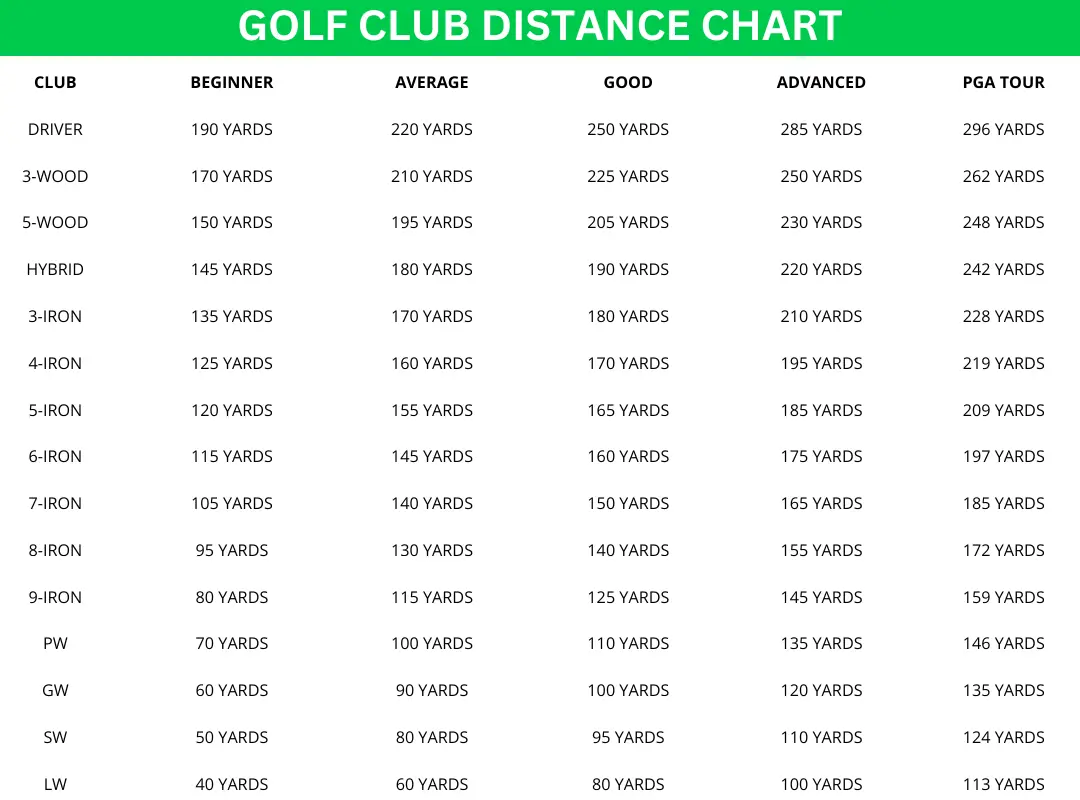
Beginner Golfer Distance Chart
| Club | Men | Women |
| Driver | 190 yards | 170 yards |
| 3-wood | 170 yards | 150 yards |
| 5-wood | 150 yards | 130 yards |
| Hybrid | 145 yards | 125 yard |
| 2-iron | 145 yards | 125 yards |
| 3-iron | 135 yards | 115 yards |
| 4-iron | 125 yards | 105 yards |
| 5-iron | 120 yards | 100 yards |
| 6-iron | 115 yards | 95 yards |
| 7-iron | 105 yards | 85 yards |
| 8-iron | 95 yards | 75 yards |
| 9-iron | 80 yards | 65 yards |
| Pitching Wedge | 70 yards | 60 yards |
| Gap Wedge | 60 yards | 50 yards |
| Sand Wedge | 55 yards | 40 yards |
| Lob Wedge | 40 yards | 35 yards |
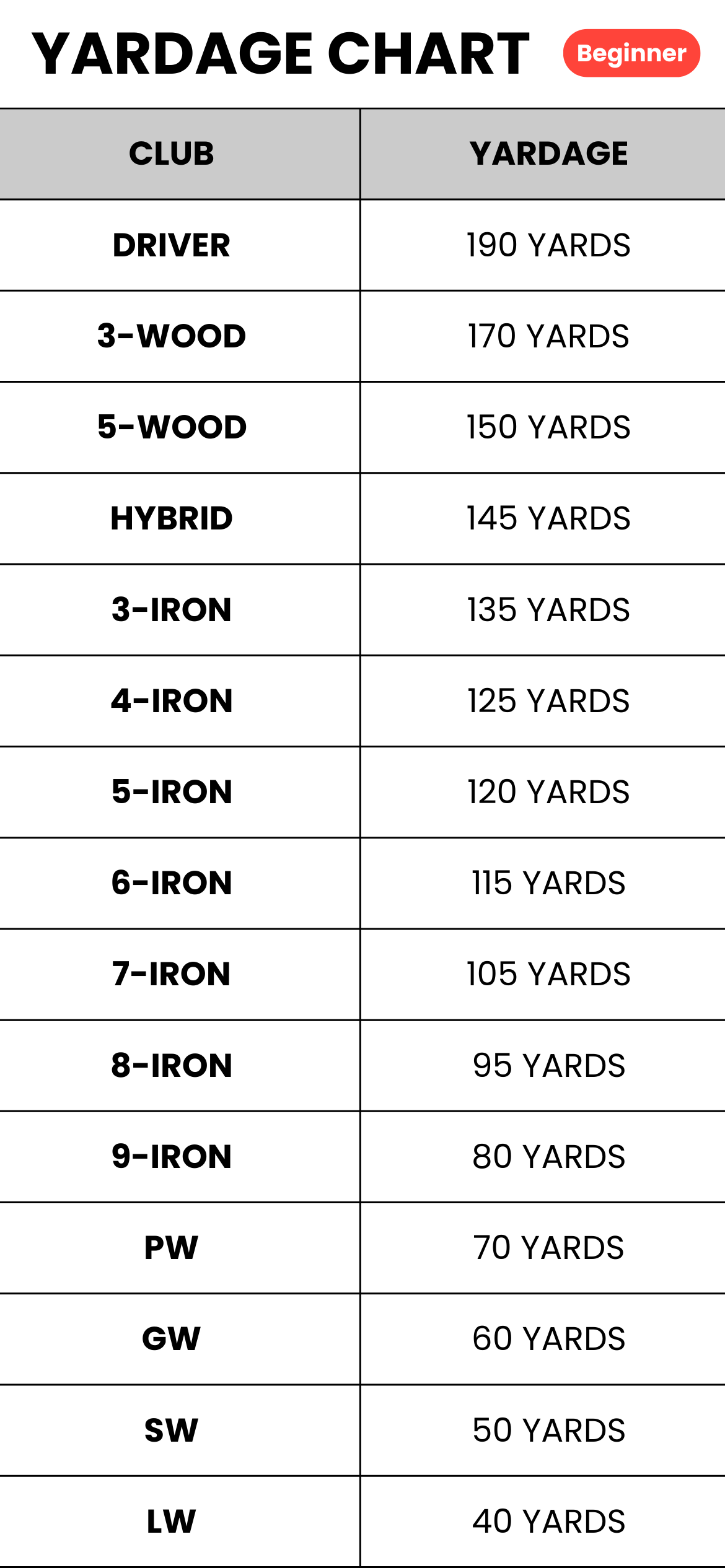
Average Golfer Distance Chart
| Club | Men | Women |
| Driver | 220-270 yards | 190-230 yards |
| 3-wood | 190-210 yards | 170-190 yards |
| 5-wood | 180-200 yards | 160-180 yards |
| Hybrid | 180-200 yards | 160-180 yards |
| 2-iron | 175-195 yards | 165-175 yards |
| 3-iron | 170-190 yards | 150-170 yards |
| 4-iron | 160-180 yards | 140-160 yards |
| 5-iron | 150-170 yards | 130-150 yards |
| 6-iron | 140-160 yards | 120-140 yards |
| 7-iron | 130-150 yards | 110-130 yards |
| 8-iron | 120-140 yards | 110-120 yards |
| 9-iron | 110-130 yards | 90-110 yards |
| Pitching Wedge | 100-120 yards | 80-100 yards |
| Gap Wedge | 90-110 yards | 70-90 yards |
| Sand Wedge | 80-100 yards | 60-80 yards |
| Lob Wedge | 60-80 yards | 40-60 yards |
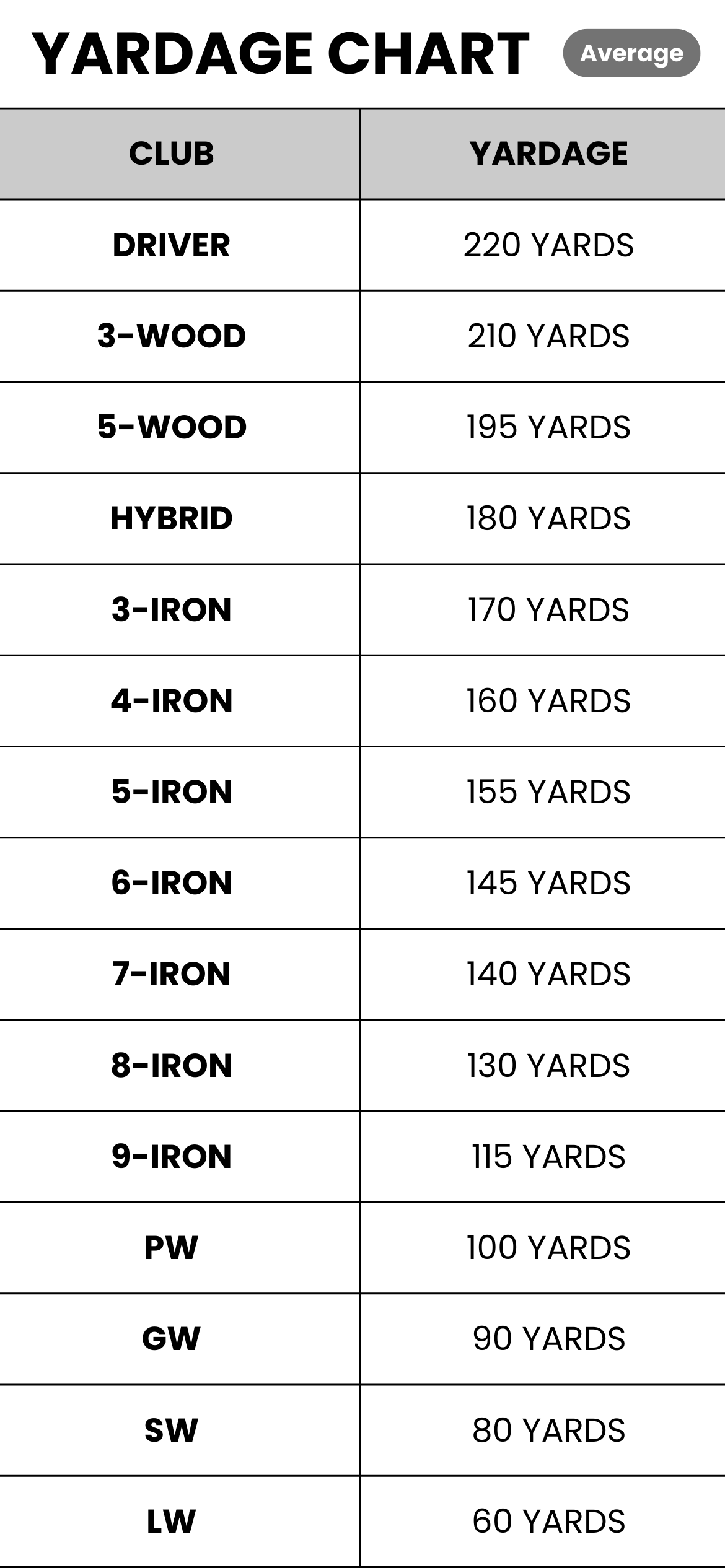
Lady Golfer Distance Chart
| Club | Women’s Average Distance | LPGA Tour Average |
| Driver | 200 yards | 258 yards |
| 3-wood | 180 yards | 228 yards |
| 5-wood | 170 yards | 216 yards |
| Hybrid | 170 yards | 211 yards |
| 2-iron | 165 yards | 206 yards |
| 3-iron | 160 yards | 199 yards |
| 4-iron | 150 yards | 190 yards |
| 5-iron | 140 yards | 182 yards |
| 6-iron | 130 yards | 172 yards |
| 7-iron | 120 yards | 161 yards |
| 8-iron | 110 yards | 150 yards |
| 9-iron | 100 yards | 139 yards |
| Pitching Wedge | 90 yards | 128 yards |
| Gap Wedge | 80 yards | 117 yards |
| Sand Wedge | 70 yards | 108 yards |
| Lob Wedge | 60 yards | 97 yards |
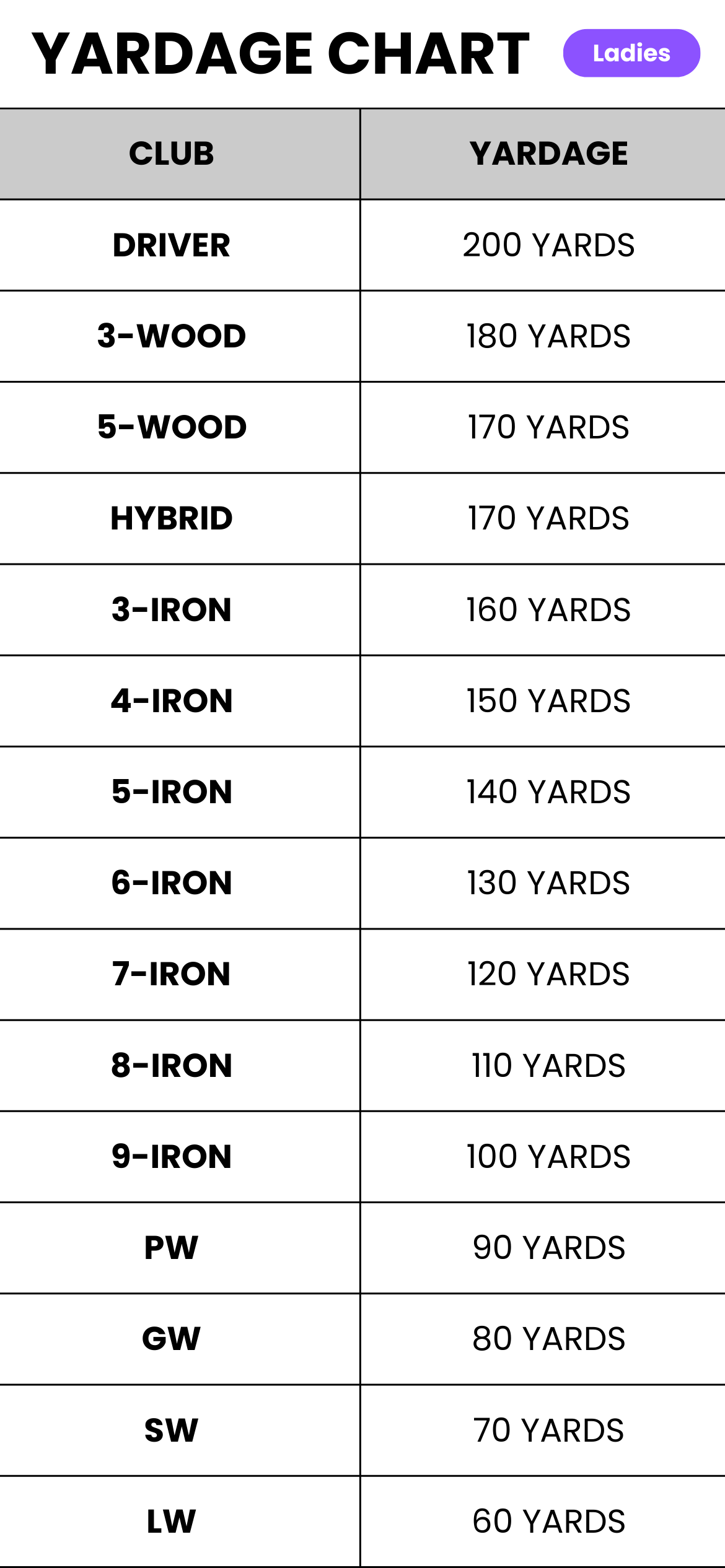
Senior Golfer Distance Chart
| Club | Senior’s Average Distance | PGA Tour Champions |
| Driver | 196 yards | 279 yards |
| 3-wood | 173 yards | 240 yards |
| 5-wood | 164 yards | 227 yards |
| Hybrid | 160 yards | 222 yards |
| 2-iron | 156 yards | 217 yards |
| 3-iron | 151 yards | 209 yards |
| 4-iron | 145 yards | 200 yards |
| 5-iron | 138 yards | 191 yards |
| 6-iron | 130 yards | 180 yards |
| 7-iron | 123 yards | 169 yards |
| 8-iron | 114 yards | 157 yards |
| 9-iron | 105 yards | 146 yards |
| Pitching Wedge | 97 yards | 136 yards |
| Gap Wedge | 89 yards | 122 yards |
| Sand Wedge | 82 yards | 108 yards |
| Lob Wedge | 74 yards | 97 yards |
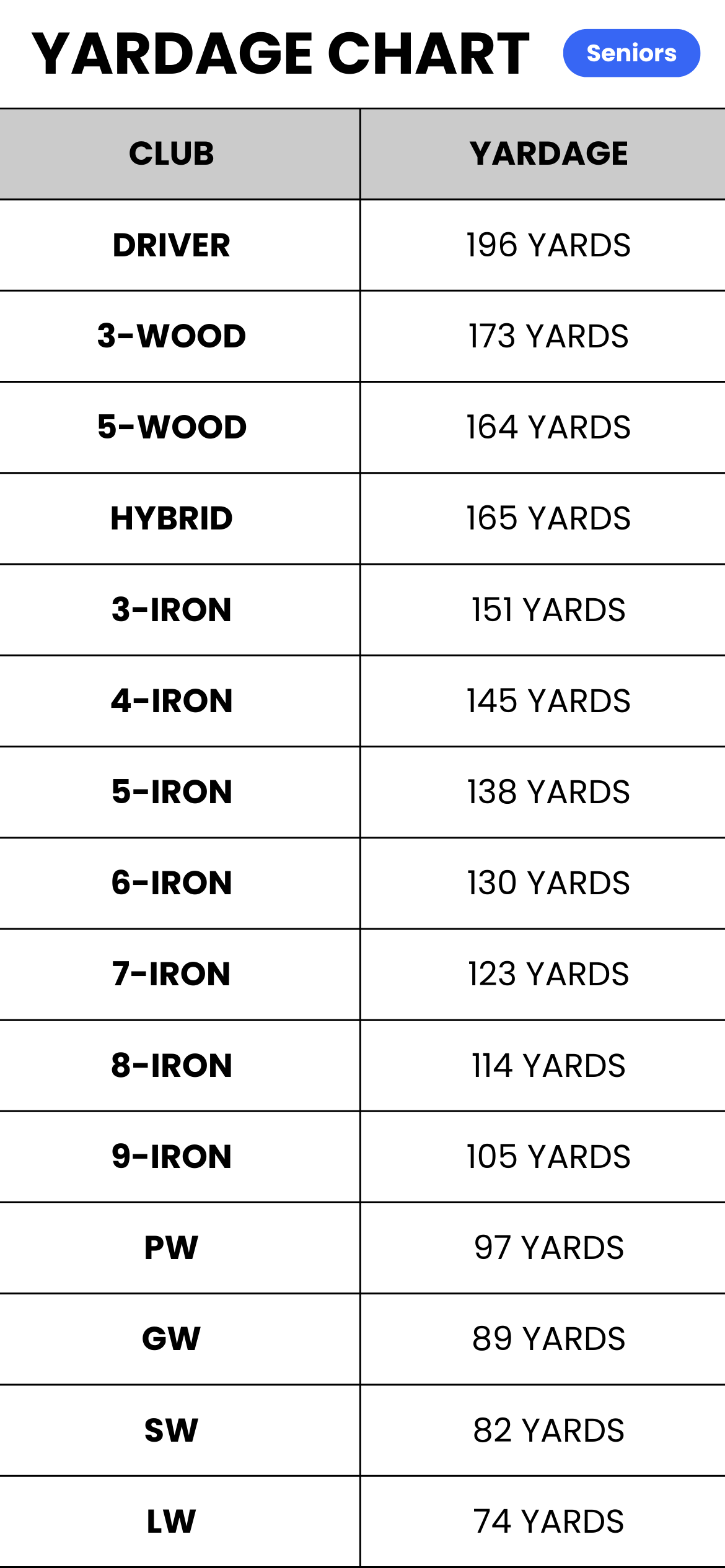
Create Your Personalized Yardage Chart in 2024
While beginner golfers can use general distance charts as a starting point, don’t rely on them completely. Your own swing, how high you hit the ball, and even the specific clubs you use can make a big difference in how far you hit each shot.
That’s why it’s important to create your own personalized yardage chart.
It’ll give you a much more accurate picture of your distances, helping you make better club choices and play smarter on the course.
This chart will reflect your unique capabilities, empowering you to make informed decisions on the course.
Here are the top software tools available to help you find the distances of your golf clubs.
1) Launch Monitors
Launch monitors offer the easiest way to create your own distance charts. They track various metrics like clubhead speed, ball speed, launch angle, and spin rate. This data is captured and the yardage chart is automatically created for you. Just set it up on your next range session and hit your clubs! The software will do the rest.
2) GPS Devices and Apps

Many GPS devices and apps now track your shots on the course, providing estimated distances for each hit. While not as precise as launch monitors, they offer an accessible and cost-effective way to gather generalized data during play.
3) Rangefinders

Rangefinders provide accurate yardage measurements to targets via laser on the range and course. This is a more traditional way to understand your yardage for each club. They’re also a must on any golf course. I recommend using a launch monitor for practice and a rangefinder for play.
Top 10 Best Golf Rangefinders for Improved Accuracy and Performance
The Evolution of Distance Charts
In the past, golfers depended on basic distance charts found in magazines or scorecards, which offered general information often based on average swing speeds and lacked personalization.
Thankfully, technology has revolutionized how golfers track their distances.
With golf gadgets like launch monitors and GPS devices, golfers can now access personalized data based on their own swing speed, launch angle, and ball strike.
This translates to far more accurate distance charts tailored specifically to each player’s abilities.
The Importance of Knowing Your Distances
Knowing your yardages in golf is crucial for several reasons:
- Club Selection: Golf involves selecting the right club for each shot based on the distance to the target. If you don’t know your yardages for each club, you’ll struggle to choose the appropriate one, leading to shots that are too short or too long.
- Course Management: Understanding your yardages allows you to plan your shots and navigate the course strategically. You can identify layup areas, avoid hazards, and position yourself for better scoring opportunities.
- Consistency and Confidence: Knowing your distances helps you develop a consistent approach to the game. You’ll have a clearer understanding of your capabilities, leading to more confident shot selection and execution.
- Lower Scores: By making informed club choices and playing strategically, you’ll improve your chances of hitting greens, getting up and down, and ultimately lowering your scores.
Key Factors Influencing Golf Club Distances
Several factors play a role in finding out how far you hit each club, some of the top reasons include:
#1 – Swing Speed
Swing speed is the biggest factor in how far you hit the ball. A faster swing means a faster clubhead, which means a faster ball and more distance.
Every 10 mph increase in swing speed can add a lot of yards to your shots.
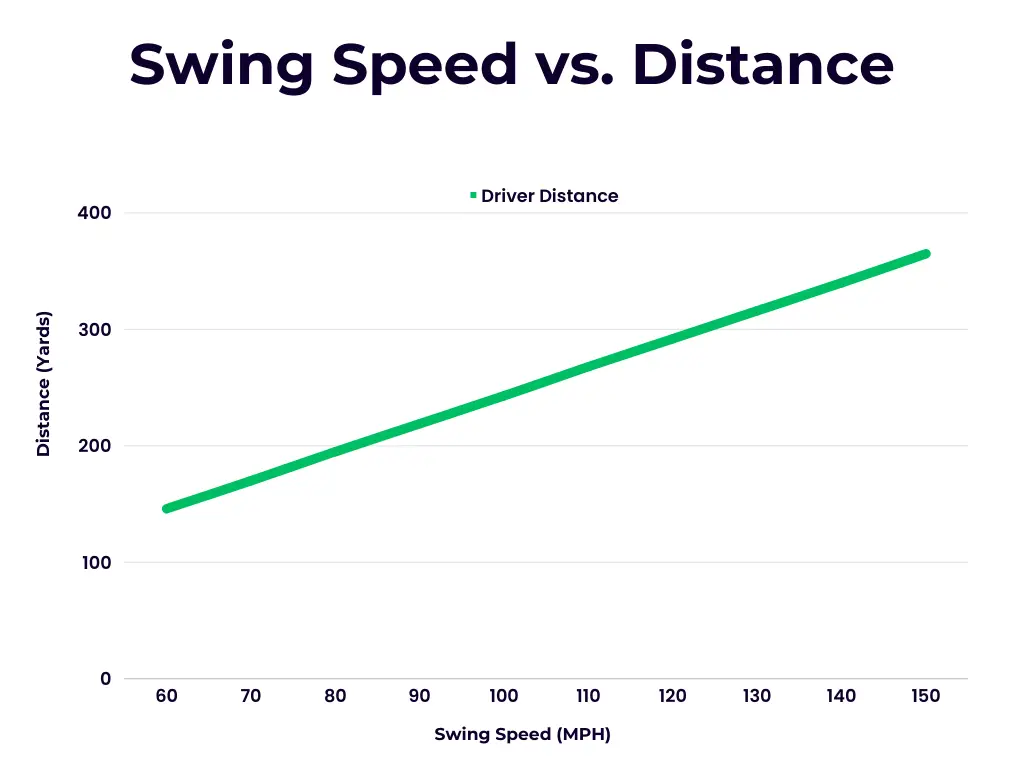
#2 – Ball Speed
Swing speed is important, but the speed of the ball when it leaves the clubface is what really determines how far it goes.
Hitting the ball squarely in the center of the clubface gives it the most speed and sends it flying farther than off-center hits.
#3 – Smash Factor
Smash factor measures how well you transfer energy from your club to the ball when you hit it.
It’s calculated by dividing the ball’s speed by the clubhead’s speed. A higher smash factor, closer to 1.5, means a more efficient transfer and longer shots.
Examples:
- Scenario 1: A golfer swings their driver with a clubhead speed of 100 mph and achieves a ball speed of 140 mph. Their smash factor would be 1.4 (140 mph / 100 mph = 1.4). This indicates a good energy transfer and likely a solid drive.
- Scenario 2: Another golfer also swings their driver at 100 mph, but their ball speed is only 130 mph. Their smash factor would be 1.3 (130 mph / 100 mph = 1.3). This suggests a less efficient energy transfer, perhaps due to an off-center hit or other factors, resulting in a shorter drive compared to the first golfer.
In essence, smash factor helps quantify the “quality” of your strike. Even with the same swing speed, two golfers can achieve different distances due to variations in smash factor.
A higher smash factor generally leads to longer shots, highlighting the importance of solid contact and efficient energy transfer.
#4 – Age and Skill Level
Age and skill play a role in how far you hit the ball.
As we get older or less fit, we might swing slower and hit it shorter.
On the other hand, experienced golfers usually swing faster and hit it farther than beginners.
#5 – Weather Conditions
Weather can affect your distances, although not as much as other factors.
Headwinds will make your shots shorter, while tailwinds can give you a boost.
Cold weather might make the ball fly a bit less far, and playing at higher altitudes can actually help you hit it longer because the air is thinner.
Conclusion
Distance charts are a valuable tool for all golfers.
They help you understand how far you hit each club and improve your game in several ways:
- Make smarter choices on the course by knowing your distances and avoiding hazards.
- Confidently choose the right club for every shot.
- Identify areas where you need to improve your distances or adjust your clubs.
- Practice more effectively by setting specific distance goals.
By creating and using your own distance chart, you’ll gain a deeper understanding of your game and make better decisions on the course, leading to lower scores and more enjoyment.
🤔 Glossary Of Yardage Terms
- Swing Speed: The speed of the clubhead at impact.
- Ball Speed: The speed of the ball after impact.
- Smash Factor: The efficiency of energy transfer from club to ball.
- Launch Angle: The angle at which the ball leaves the ground.
- Carry Distance: The distance the ball travels in the air before landing.
- Roll Distance: The distance the ball rolls after landing.
- Layup: A strategic shot aimed at a safe location on the course, often short of the green.
Downloadable Distance Charts:
